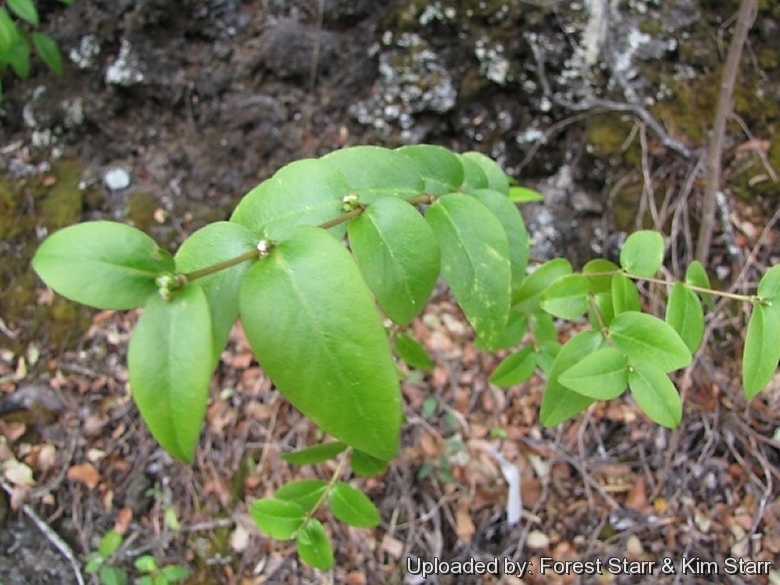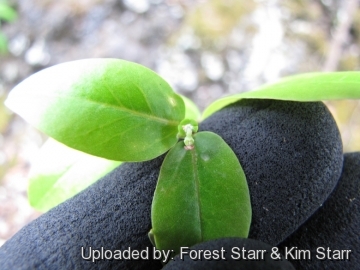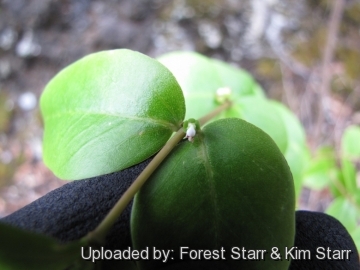
Euphorbia multiformis Photo by: Forest Starr & Kim Starr
Habit at Honokowai Ditch Trail, Maui, Hawaii (USA). June 21, 2010.
Origin and Habitat: Hawaiian Islands, endemic to O`ahu, Maui.
Synonyms:
See all synonyms of Euphorbia multiformis
back
Accepted name in llifle Database:Euphorbia multiformis Gaudich. ex Hook. & Arn.Bot. Beechey Voy. 95 (1832)Synonymy: 7
back
Common Names include:
ENGLISH: Variable sandmat
HAWAIIAN (ʻŌlelo Hawaiʻi): Akoko, Ekoko, Koko, Kokomalei, Kōkōmālei, ʻakoko, ʻEkoko, Ako-koko, A-koko
Description: Euphorbia multiformisSN|28904]]SN|28959]] is a low-growing and somewhat dwarfed-looking perennial shrub in the Spurge Family, having whitish trunk and thick leaves with acute apices.
Taxonomy: Euphorbia multiformisSN|28959]]SN|28959]] was previously considered synonym of Euphorbia celastroidesSN|28959]]SN|28904]] and the descriptions regarding this species found in botanical literature often refers to celastroides. There remains a considerable confusion surrounding the true identity of this species.
Stems: Branches 0.5-2(-3) m long, slender, wiry and nodose (and often decompound), glabrous to pilose or glabrate, flowering branches 1-1.5 mm in diameter. Internodes of a main branch up to 32 (or more) mm long, of branchlets mostly under 20 mm long.
Leaves: Opposite, distichous (growing in two vertical rows), elliptic to ovate or obovate, (9-)15-40(-65) mm long, (4-)7-15(-25) mm wide, glabrous to pilose at basal margin, margins entire, apex acute to rounded, retuse, occasionally mucronulate, base rounded, oblique, petioles 1-3 mm long, glabrous to pilose above, stipules acute-triangular, 0.5-1.5(-2) mm long, erose, ciliate.
Flowers (Cyathia): Solitary in the leaf axils or 3-10 in cymes on shortened branches, peduncles 0.5-2 mm long, glabrous to pilose; involucre campanulate, 1.5-2.5 mm high, 1.5-3.5 mm wide, glabrous to pilose or villous beneath the glands, glands 4, green to red or purple, glabrous to pilose below; styles red to yellow, bifid 1/2 or more their length, 0.3-1 mm long, glabrous or pubescent; stigmas not thickened.
Fruit (capsules: Green to red, 1.5-3 mm long, glabrous to slightly pilose on sutures, glabrate, gynophores recurved, exserted 2-3 mm from involucre, ± pilose.
Seeds: Ovate, tetragonal, greyish to brown, (1.2-)1.5-2 mm long, rugose.
Chromosome number: 2n = 38 (in all varieties)
Bibliography: Major references and further lectures
1) Forest & Kim Starr “Euphorbia multiformis var. multiformis (Akoko, kokomalei)”. Plants of Hawaii. <http://www.starrenvironmental.com>. Web. 27 Sep. 2014.
2) D. M. Kaaiakamanu, J. K. Akina “Hawaiian Herbs of Medicinal Value” The Minerva Group, Inc., 01/May/2003
3) Beatrice Krauss "Plants in Hawaiian Culture" Univ of Hawaii Pr August 4, 2001
4) Marie C. Neal "In Gardens of Hawaii" June 1, 1965
5) S. H. Sohmer, R. Gustafson “Plants and Flowers of Hawai_i” University of Hawaii Press, 1987
6) Alan C. Ziegler “Hawaiian Natural History, Ecology, and Evolution” University of Hawaii Press, 2002
7) Walter H. Lewis “Medical Botany: Plants Affecting Human Health” John Wiley & Sons, 04/Sep/2003
8) Wagner, W. L., M. Bruegmann, D. R. Herbst, and J. Q. Lau. 1999. "Hawaiian Vascular Plants at Risk" 1999. Bishop Mus. Occas. Pap. 60: 1–64.
9) Wagner, W. L. et al. 1990. "Manual of the flowering plants of Hawai`i." University of Hawaii Press. (Bishop Museum Special Publication 83).
10) Wagner, W. L. et al. 1999. "Manual of the flowering plants of Hawai`i" revised edition with supplement by Wagner, W. L. and D. R. Herbst, pp. 1855–1918. University of Hawaii Press, 1919 pp. in 2 volumes. (Bishop Museum Special Publication 97)
11) National Museum of Natural History “Euphorbia multiformis” in “Flora of the Hawaiian Islands” <http://botany.si.edu/pacificislandbiodiversity/hawaiianflora/> Smithsonian Institution Web. 27 Sep. 2014
 Leaves and fruit at Honokowai Ditch Trail, Maui, Hawaii (USA). June 21, 2010. Photo by: Forest Starr & Kim Starr
Leaves and fruit at Honokowai Ditch Trail, Maui, Hawaii (USA). June 21, 2010. Photo by: Forest Starr & Kim Starr Leaves and fruit with white sap at Honokowai Ditch Trail, Maui, Hawaii (USA). June 21, 2010. Photo by: Forest Starr & Kim Starr
Leaves and fruit with white sap at Honokowai Ditch Trail, Maui, Hawaii (USA). June 21, 2010. Photo by: Forest Starr & Kim StarrCultivation and Propagation: Euphorbia multiformisSN|28959]]SN|28959]] is a low growing sprawling tropical shrub that requires temperatures of 15 °C and full sun to light shade. This plant develops in a fashion similar to a shrub and is usually not cultivated.
Potting medium: A gritty, very free-draining compost is suitable, and clay pots help the plants to dry out between watering. Re-pot every 2-3 years.
Fertilization: It respond well to liquid fertilizer (once every one to two months).
Waterings: They like only a short winter's rest and should be kept almost completely dry during the winter months. If the soil is allowed to be dry for too long root loss could follow but equally the same result would occur if the plants are both wet and cold. From March onwards the plant will begin to grow and watering should be increased gradually until late May when the plant should be in full growth. Water regularly during the summer so long as the plant pot is allowed to drain and not sit in a tray of water. During hot weather you may need to water the plants more frequently so long as the plant is actively growing. From late September watering should be reduced to force the plant to go in to a state of semi dormancy, by October you should be back in to the winter watering regime.
Pruning: Generally not necessary to prune plants except to remove dead branches and leaves for a cleaner appearance in the landscape. However this species do tend to get sort of leggy, which is particularly a problem if grown as a potted plant, and pruning is sometime necessary to shape. Repeatedly prunings also help to encourage new growth. A milky, sticky latex naturally oozes from wounds.
Hawaiian Uses: Buds and leaves were used by Hawaiians for general body debility.
Pest and diseases: They are susceptible to fungal diseases. Wet soil quickly causes root and stem rot, especially during winter months. Pests include whitefly, scale insects, and mealybugs. Often the scale in-sects and mealybugs are brought in and protected by ants. Spider mites can also can damage to leaves.
Propagation: Seeds or cuttings. It is best to collect seed just before or just after the capsules split open to be sure to have fresh but mature seeds. Because of the small size of the seedlings, place little or no cover over the seedbed. Take extra care to avoid letting the seedbed dry out. The seeds will begin sprouting in one to two weeks (sometimes take longer). Let the seedlings grow to about 5 cm in height before separating and transplanting to individual containers. You can also propagate it by stem tip cuttings. Take cuttings about 10 cm in length from actively growing tips with mostly green wood. After root growth and new stem growth are obvious, transfer the new plant to a standard potting mix.












